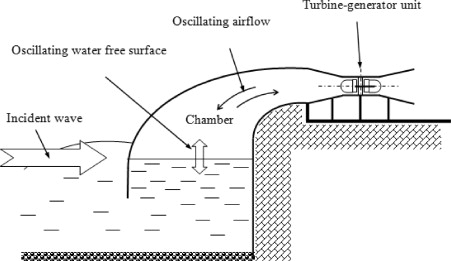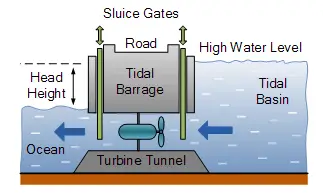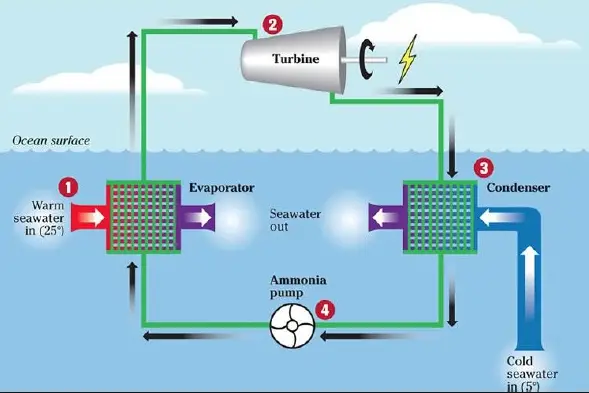Ocean energy is an indirect form of solar energy. The oceans and seas constitute about 70% of the earth’s surface area, so they act as a large reservoir of solar energy.
- On an average, the 60 million km2 of tropical seas absorb solar radiation equivalent to the heat content of 245 billion barrels of oil.
- On an average, the 60 million km2 of tropical seas absorb solar radiation equivalent to the heat content of 245 billion barrels of oil.
- The major oceanic sources of energy are wave energy, tidal energy and Ocean Thermal Energy Conversions (OTEC). However, the energy emanating from the surface water evaporation by solar heating, i.e., hydrological cycle is also a form of ocean energy.
- These energy sources except tidal are the results of the absorption of solar radiation by seas and oceans which cause wind, ocean currents and moderate temperature gradients from the water surface downward, especially in tropical water.
1. Wave Energy
The endless motion of the sea surface in the form of wind waves constitutes a source of energy, which is known as wave energy. Extraction of energy from waves is more efficient than direct collection of power from wind, since the wave energy is concentrated through the interaction of the wind and the free ocean surface.

Due to their periodic nature and huge energy contained, waves can be used to run a turbine and thus generate electricity. The most common technique of harnessing this energy is a turbine coupled with an electrical generator system. But the main problem in the system is its inability to produce electricity if airflow velocity increases beyond the designed value.
- The first wave energy project in India was set up at Vizhinjam near Thiruvananthapuram in Kerala with the capacity of 150 MW.
- Department of Ocean Development (DOD) is the nodal agency to harness wave energy in India.
- India’s vast coastline of 7500 kms has a wave potential 40,000 MW.
- Ocean Engineering Centre (OEC) plans to erect 5 similar plants at Thangassery in Kerala and also a plant in Andaman and Nicobar Islands.
Advantages of Wave Energy
- It is a free, renewable and pollution free energy resource.
- The energy density of wave energy is greater than that of wind as well as solar.
- Wave power devices do not require large land masses like solar or wind power devices.
Limitations of Wave Energy
- With present state of technologies, wave power is expensive.
- Relative scarcity of accessible sites of large wave activity.
- Wave energy extraction equipment must be capable of operating in a marine environment and withstanding very severe stresses in storms.
- Marine mammal and sea bird population could also be affected by the physical presence of wave energy structures.
2. Tidal Energy
Energy can be extracted from the tides which are formed due to the gravitational effect of the sun and moon on the Earth. This gravitational force causes a periodic rise and fall of the water level of sea which can be used to produce electric power. Such type of energy is known as tidal energy.
- India has a potential of tidal energy with capacity of 9000 MW. In this, 8000 MW power can be produced in Gulf of Cambay and Gulf of Kutch alone.
- The Central Electricity Authority (CEA) is the nodal agency for setting up tidal energy projects.

- During the high tide, the height of the tide is above that of tidal basin and the turbine unit operates and generates power. During low tides, the height of tide is lower than that of the tidal basin and water is allowed to flow out to drive or propel the turbine unit.
- Hydraulic turbine and generator are coupled to generate electricity. The tidal power plant requires a great tidal range and a suitable bay where a dam can be construct which will store water and release it during low tides to run a turbine.
Advantages of Tidal Energy
- Tidal energy is a pollution free source of energy, as it does not use any fuel and also does not produce any unhealthy waste.
- Tidal power plants do not require large areas of valuable land, as they are on the bay or estuaries.
- Besides, being inexhaustible, it is completely independent of the uncertainty of the precipitation (rainfall, etc.). Even if there is a continuous dry spell for many years, there will be no effect whatsoever on tidal power generation.
- It is available all round the year.
Limitations of Tidal Energy
- Tidal power schemes require low-head turbines, which are larger and more expensive than high-head turbines of similar power production.
- Since the tidal ranges are highly variable, therefore the turbines have to work on a wide range of head variation.
- Tidal power plants hamper other natural uses of estuaries such as fishing, migration of marine organisms Or navigation.
- Low power production.
- Complex design system.
Ocean Thermal Energy Conversions (OTEC)
- Ocean thermal energy conversions make use of the temperature difference between the surface water of the oceans and the depth of the oceans.
- A huge amount of solar energy is stored by the tropical oceans, which is used to generate electricity.
- The ocean thermal energy can be harnessed in tropical oceans where the temperature gradient is the highest around 28°C on top and about 5°C at the depth of 1000 meters.
- In the oceans, the temperature difference between surface and deep water is highest in the tropics with 20 to 25°C.
- Some of the best sites for OTEC are situated along the coast of Tamil Nadu, Lakshadweep, Andaman and Nicobar.

Principle of Working
The operation of OTEC plant is based upon thermodynamic principle in which if a heat source is available at a higher temperature and a heat sink at a lower temperature then the temperature difference can be utilized to run a prime mover (e.g., turbine), which can convert part of the heat taken from source into mechanical energy. The residual heat is discharge to the sink at lower temperature.
Advantages of OTEC
- The advantage of OTEC is that power is continuous, renewable and pollution-free.
- A floating OTEC plant can generate power even at mid sea and can be used to provide power for operations like offshore mining and processing of manganese nodules.
